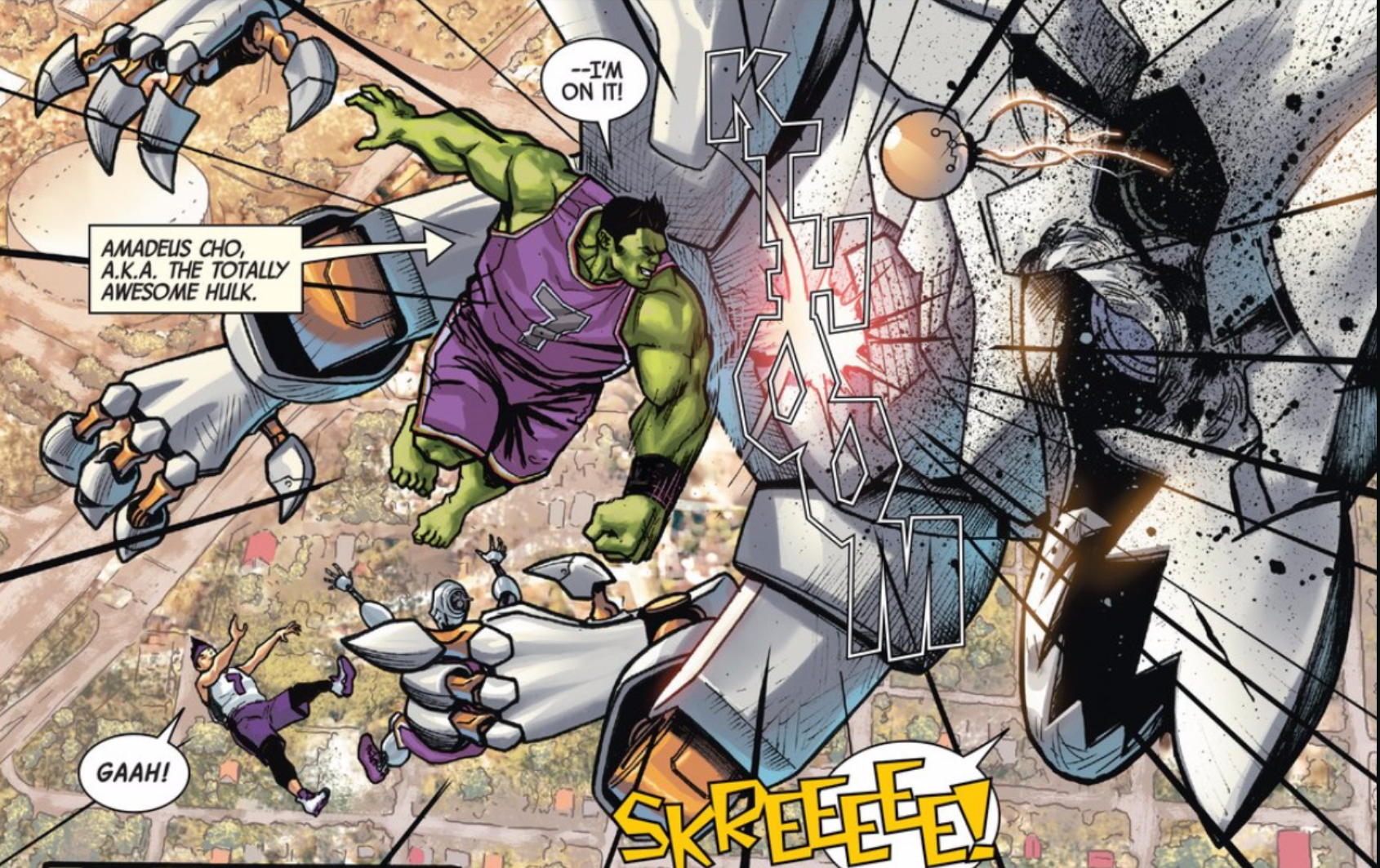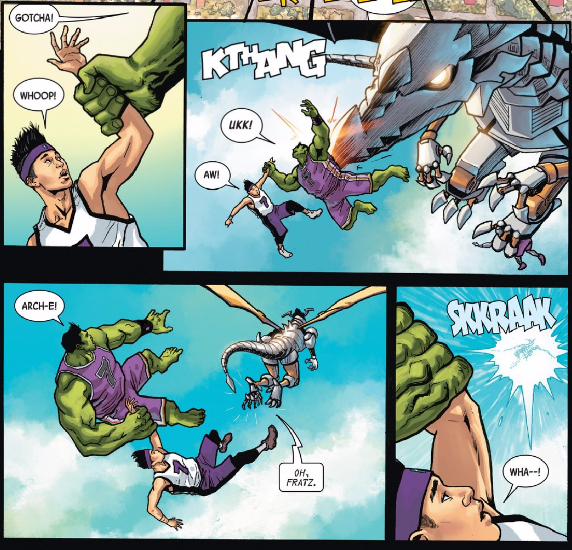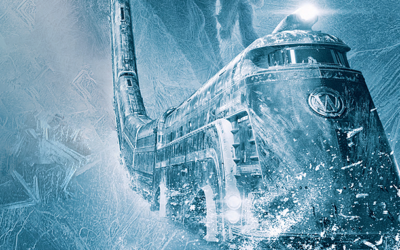We don’t want to alarm anyone…but Jeremy Lin might dead.
Or a super-strong mutant.
Or…something.
Previously, in talking about Squirrel Girl and her fall with the Rhino, I explained that checking The Unbeatable Squirrel Girl’s science of her fall would be something I would assign to my physics students with no problem. I also mentioned that I had assigned them a problem recently as well – basketball star Jeremy Lin’s fall from a height in The Totally Awesome Hulk #14 (possibly still on the shelves of your local comic shop, or digitally at Comixology.)
As for how Jeremy Lin got into The Totally Awesome Hulk in the first place…well…
We’ve talked before about how the current Hulk in Marvel Comics’ continuity is Amadeus Cho, “the 7th Smartest Man in the World.” How Cho got to be the Hulk is a story we don’t need to get into now, but it dealt with fusion, gamma radiation, and rescuing Bruce Banner.
Anyway.
Lin guest-starred in a two-part storyline in issues #13 and #14, featuring some street ball with Cho, and a benefit basketball game that included robots, aliens and monsters, all playing for a good cause.
So of course a giant robo-dragon attacked.
In the ensuing confusion, Lin and his robot pal Arch-E-5912 were lifted up by the dragon to a height of 206 feet. Hey – that’s what Arch-E said, and I think we can trust a robot when it comes to measuring – and we won’t hold the fact that he’s a robot who measures in feet against him.
The Hulk (Cho) – who’s frustratingly impetuous for such a smart guy – attacks the robo-dragon and frees Lin. The Hulk grabs on to Lin, and the two free fall for the 206 feet, landing with a KTHOOOOM.
That’s the setup I gave to my students, straight out of issues #13 and #14, and I asked them one simple
question – what force does Jeremy Lin experience when he and the Hulk land?
There were a couple of different ways you could analyze the fall, but I was looking for the force. I was hoping my students would treat it as a momentum-impulse problem.
As with all of these problems, we start with what we know (and can easily find out or estimate) and what we’re trying to find out, so…
What do we know?
- They’re 206 feet up. That’s roughly 63 meters.
- The Hulk’s mass is 293 kg (from the last time we worried about the Hulk and his motion)
- Jeremy Lin’s mass is 91 kg (sports statistics are everywhere!)
- Their initial velocity downward is 0 m/s
- They fall with an acceleration of 9.8 m/s2
- The time to come to a stop when landing – I told my students this was something that they would have to look up, and the consensus they found was about 0.15 seconds.
What do we want to find out?
- The maximum speed the Lin-Hulk combo reaches on their trip down.
- The force experienced by Jeremy Lin when he suddenly stops – yes, even though the Hulk is cradling him. It’s not going to be good, most likely.
Step-wise? What do we do?
Step #1: Figure out how fast the Lin-Hulk combo is falling after they’ve fallen 63 meters.
Step #2: Calculate the force felt by Lin when he comes to a sudden stop (yes, even though he’s in the Hulk’s arms). That will be done by calculating the impulse or the change in momentum felt by Lin.
That should do it.
One note – to be as close to accurate as possible, let’s make sure we’re talking about Lin’s real final height – he’s not on the ground. He’s maybe one meter up, so we can say that his total fall is 62 meters. 63 meters in the sky to stop one meter above the ground.
Let’s run some numbers:
It’s Raining Hulks! (and NBA Players)
I used this problem as a review of concepts they should have remembered from year 1 physics, and got them to focus on kinematics. They could have solved this starting with energy conservation (the Lin-Hulk combo had a gravitational potential energy at 63 meters, and thus a maximum kinetic energy at the ground, and the velocity could have been calculated from that…), but I wanted them to dust off kinematics.
My students could have approached this one of two ways – first, figure out how long it took the Lin-Hulk to fall, and then from that, figure out how fast they were falling when they reached their lowest point. But that’s adding in an extra step. They really just needed the velocity of the pair after falling for 62 meters (in Lin’s case), so I’d hope they’d use:
v2 = 2gh
That is, the square of the velocity is equal to twice the acceleration due to gravity (g) multiplied by the height from which they fall. Plugging in numbers:
v2 = 2(-9.8)(62) = 1215 = 35 m/s.
Just to bring it into a more real-world context, that’s about 78 mph. You can probably see where this is heading.
Kthoooom, Indeed
Jeremy Lin comes to a stop while cradled in the Hulk’s arms. Okay, what he’s cradled in doesn’t really matter. It’s that stop, and the force he feels as a result of his speed changing from roughly 78 mph to 0 mph in about 0.15 seconds. This is about momentum.
The momentum of any moving object is the product of its mass and its velocity. To change momentum, you need a force applied for a period of time. This is called an Impulse. The overall formula for Impulse comes from Newton’s Second Law of Motion, F = (mass) x (acceleration). Since acceleration is equal to the change in velocity divided by time (a = Δv/t), if we multiply both sides of Newton’s 2nd by time, we get:
Ft = mΔv
To calculate how much force is needed to change an object’s momentum (say, to slow it from 35 m/s to 0 m/s), we divide both sides of the equation by time, ending up with:
F = mΔv/t
From this relationship, it’s easy to see that the larger the value of time is, the less force is required to change the momentum of the object. The less time, the more force is required. In regards to the force experienced by an object – same thing. If the momentum changes a large amount in a short time, then the object experienced a large force. Increase the amount of time the change in momentum takes, and the less force the object experiences.
It’s one of the reasons cars have airbags – you’re traveling at a high rate of speed, and you’re going to slow down to zero. It’s highly beneficial to you if you can spread that slowdown (the change in momentum) out over the largest possible time. The airbag slows your forward motion down, and as a result, you take more time to move forward. You experience less force.
So let’s get back to Lin in Hulk’s arms, and put our numbers in. A good stopping time, as mentioned above, is 0.15 seconds. This might get ugly.
F = mΔv/t
F = (91)(35)/.15
F = 21,233 N
That’s about 4773 pounds of force experienced by Lin when he comes to a sudden stop in the Hulk’s arms. Jeremy Lin weighs (in pounds) about 200 pounds, so Lin experienced a force 24 times his body’s weight upon landing, basically 24 G’s.
Okay – some caveats:
Yes, the Hulk could have flexed his legs a little upon landing, cushioning the touchdown. That would have increased the time it took Lin to come to a full stop, but not by any meaningful amount. Try it! Put numbers in for time above (replace the .15 seconds) and see what you get. 2 or 3 G’s would leave Lin with some heavy bruising at the points of contact with the Hulk, but to get the values down that low, the Hulk would have to have used about a full second to come to a stop. Not entirely out of the realm of possibility for the Hulk, but at best, difficult to make happen, given the Hulk’s human anatomy and velocity.
So my students did pretty well on this problem, with one drawing a fairly two-dimensional picture of Lin after the fall, stating that he’d just be a stain. “Bag of pudding” was another popular comment. Everyone got some extra credit on this problem – I was happy to see that they remembered some of the ideas we’d learned earlier.
Jeremy Lin: Superhero?
All of this, of course, brings us to a series of questions, some of them with disturbing implications.
- As Lin is seen to be up and walking around immediately after the impact, he survived. What is he made of? Does he have an adamantium skeleton like Wolverine or something?
- Hey, this is comics – is Lin even still alive? Has everything after the impact been a dream or some wishful thinking by the Hulk?
Why? How? And why am I even walking down that dark, dark path?
Ask any physics aficionado/comic book reader. Impulse kills – it’s killed before and changed a hero forever. 1973: Amazing Spider-Man #121. Gwen Stacy. Spider-Man. The Green Goblin. The George Washington Bridge. A fall. An ill-fated webbing shot.
(by the way, “Gwenfall” is a problem that my Physics 1 class works through in the momentum-impulse unit. It’s easily adaptable to classroom use, and the death still has impact when my students realize what happened. Science as story makes for increased student engagement.)
Let’s call in Dr. James Kakalios to explain what happened with Gwen. The following video…1) well, the math will seem familiar, and 2) is a presentation of a chapter from his excellent book The Physics of Super Heroes – “The Day Gwen Stacy Died – Impulse and Momentum.”
According to Kakalios’ math, Gwen died when she encountered a force of about 910 pounds, nine times her body weight.
And of course, movie makers adapted the scene for The Amazing Spider-Man 2. It was on of the many sad moments in the film.
https://www.youtube.com/watch?v=A6if4GOyWqs
But Jeremy Lin handled 24 times his body weight and survived to walk away. So clearly something is going on with Jeremy Lin. Or something is going on with the physics of the Marvel Universe.
Or…something.
Props go to my students Georgia Burgess and Chandler Keith who carried the problem through and figured out all the steps without a mistake.













